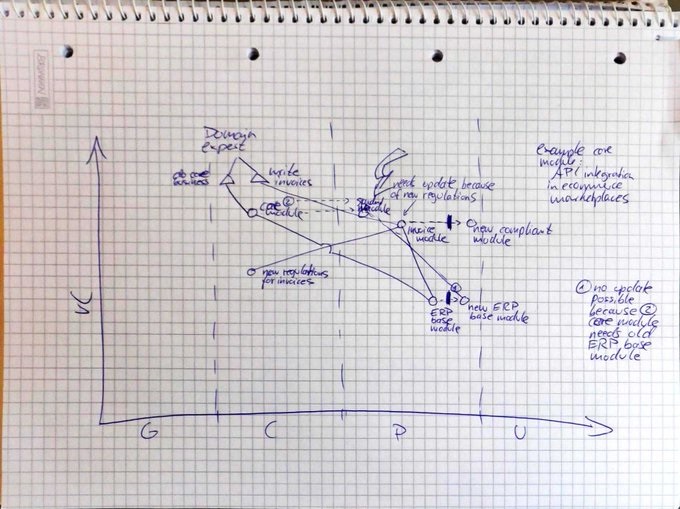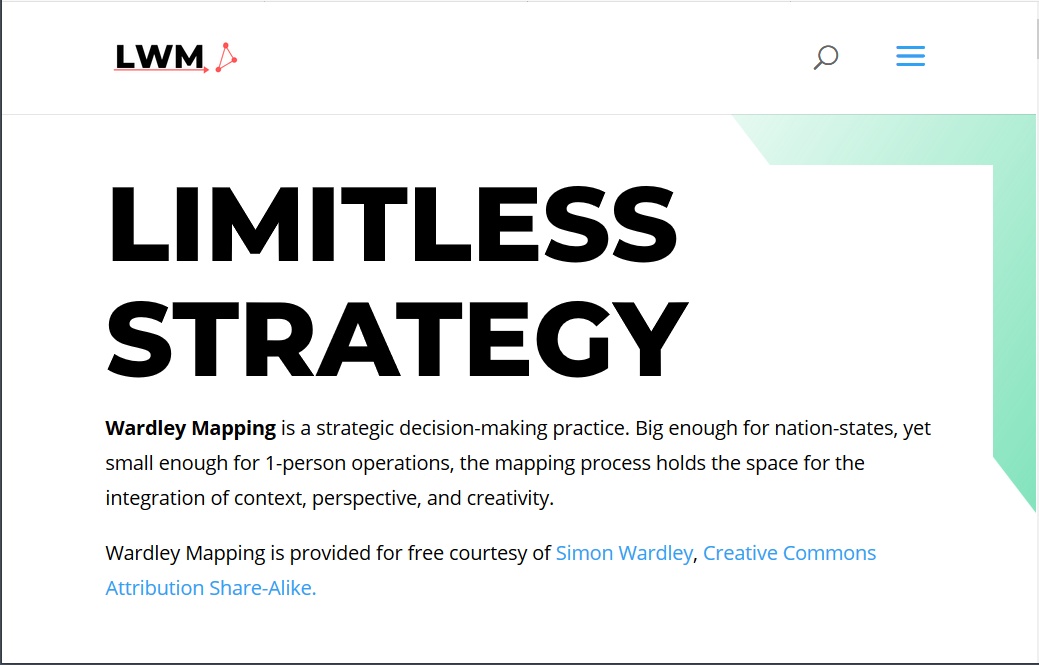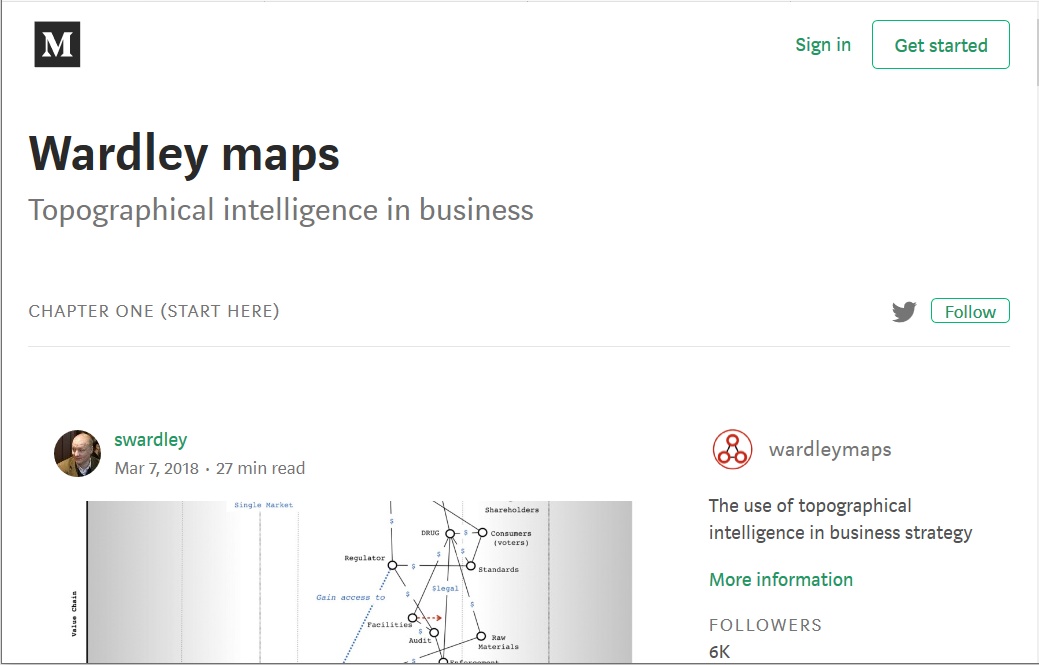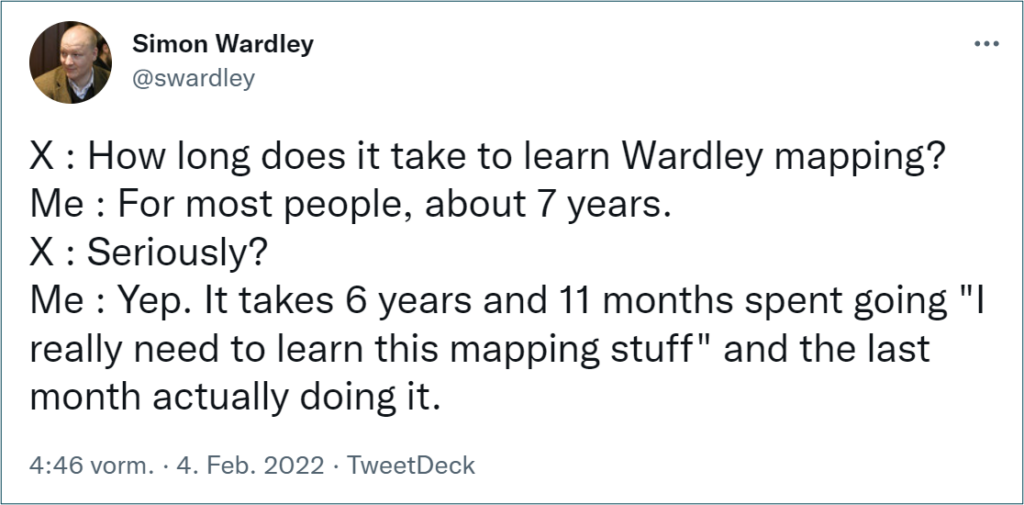People at conferences and meetups often ask me what I would recommend learning X or Y. I’m always happy to give some suggestions depending on the experience level of the person that asked. Unfortunately, this doesn’t scale very much, so here are my general recommendations for learning something very effective. This time: Wardley Maps.
Wardley Maps are a fascinating topic: They bring light into the dark times of IT departments and other institutes that are under big pressure these days.

A scribbled Wardley Map
(skip the following section if you just want to learn Wardley Mapping)
A little bit of my personal history with Wardley Maps
A colleague of mine introduced me to this strategic tool at the beginning of 2019. I went to the blog post series of Simon Wardley (the creator of Wardley Maps) and could not parse and process all the information there. I also had no time to read through a 500+ pages book at this time. So I abandoned the idea of learning Wardley Mapping. Later on, ThoughtWorks decided to put Wardley Mapping to the “assess” phase on their Technology Radar in April 2019. There, I again came across Wardley Maps and wondered why everybody seems to be so fascinated by Wardley Mapping.
I’ve got interested again and watched my first Simon Wardley video (TOP 2). It was nice, but I didn’t understand anything. But he got me at “high-level situational awareness environments are context-specific”. So I watched another one and didn’t understand everything. And another one and got some ideas where this leads to. And finally, it clicked. I was absolutely fascinated by the richness and detail Simon had added step by step over the last few years to Wardley Mapping. I think I watched all videos of Simon that were available on the internet in mid-2019.
By coincidence, I also got into the training business around the topics “software modernization” and “IT transformation”. With Wardley Maps, I think I’ve got a great tool to reason about overgrown IT landscapes out there and how to visualize the current state as well as thinking about future options with a nice, comprehensible map. I’m still learning to map. But I do it while teaching others so that they can help themselves out of the darkness ☺️.
OK, that was my little story. But now, without further ado, here are my recommendations for you!
TOP 1: Investing in innovation – How situational awareness can put your business on the map (Video)
Link: https://www.youtube.com/watch?v=Gfq3ocmadZo
A short explanatory video about Wardley Maps. It’s a great teaser that explains what Wardley Mapping is about and how you can create a map.
TOP 2: Simon Wardley – Situation Normal, Everything Must Change (Video)
Link: https://www.youtube.com/watch?v=Ty6pOVEc3bA
Short and very entertaining lecture by Simon Wardley himself. See the power of topographical intelligence from the creator of Wardley Maps!
Alternative: There is a newer series on YouTube where Simon Wardley explains the core concepts of Wardley Maps in a more sober way: YouTube playlist.
TOP 3: learnwardleymapping.com (Website)
Link: https://learnwardleymapping.com/
A website for beginners to learn Wardley Mapping by Ben Mosior. There are also videos that explain the different chapters of Simon Wardley’s book (Patreon supported). Ben also published a video showing you how to start mapping within 10 minutes!

Ben is also offering an online course and Wardley Mapping sessions.
TOP 4: Adrian Cockroft – Mapping Your Stack (Video)
Link: https://www.youtube.com/watch?v=4cp5qtLkPcY
A longer talk by Adrian Cockcroft from Amazon Web Services on cloud mapping (to AWS, of course 😉 ) with Wardley Maps. I find this video valueable because you see another person’s application of Wardley Maps.
TOP 5: Simon Wardley – Wardley maps: Topographical intelligence in business (“The Book”)
Link: https://medium.com/wardleymaps
Free (reference) book by Simon Wardley, well written and published as a series of blog posts. It’s the biggest source of knowledge you can have in one place. There are many gems in ther, e.g., a step by step guide (link leads to the online HTML version) for creating a map. There is also an audiobook version of the book available as well as an Asciidoc / mobi / PDF version if you want to consume the book differently than reading through the blog posts.

Last but not least
I think you just have to start mapping and try it out. There is kind of a meme here from Simon Wardley that tells the story of so many people. So, again: Just start to map!
Source: https://twitter.com/swardley/status/1489445302209814530
Also highly recommended
And there is also a great paid online course available (on Pluralsight): https://www.pluralsight.com/cloud-guru/courses/wardley-mapping
Simon Wardley lists his recommended order of blog posts (in case you want an alternative to his book): https://blog.gardeviance.org/2015/03/wardley-map-set-of-useful-posts.html
Maybe recommended
I gave a talk at the WeAreDevelopers Conference in Berlin back in 2023, where I shared my perspective on Wardley Mapping for developers. It might be of interest to you, too? https://www.youtube.com/watch?v=6hXpbZ7TpP4
Resources for German speakers
Hier findet ihr einige zusätzliche, deutschsprachige Ressourcen:
- Eine kurze Einführung von Michael Bernecker: https://www.youtube.com/watch?v=kTZPdliUOnI
- Vortrag von Oliver Finker “Einführung in Wardley Mapping”: https://www.youtube.com/watch?v=cE8-eNIK8Oc
- Podcast-Episoden zur “Wardley Mapping” vom “Smarter Entwickeln” Podcast von Florian Kuhnke. Episoden-Download-Liste:
- Inspirierender Vortrag von Markus Andrezak “Innovation. Konfusion. Enttäuschung. Verzweiflung.”: https://www.youtube.com/watch?v=gS3r11-63fk
- Von mir gibt es mittlerweile auch einen Vortrag, den ich im Rahmen des INNOQ Technology Lunchs gegeben hatte: https://www.innoq.com/de/talks/2020/04/software-modernisierung-wardley-maps-technology-lunch/
Ich selbst arbeite derzeit an dem Buch “Strategische Spielzüge – Softwaresysteme listig weiterentwickeln”, wo ich einige Kernideen von Simon Wardley im Kontext der Softwaremodernisierung betrachte.
Update Juni 2023: Über den Trainingsanbieter socreatory biete ich einen Hands-on-Einstieg in Wardley Maps an!
Update November 2024: Hier sind die Slides zu meinem eintägigen Wardley-Mapping-Workshop. Vielleicht helfen sie Wardley-Mapping-Interessierten, Einblicke über die Basics hinaus zu gewinnen: https://speakerdeck.com/feststelltaste/hands-on-einstieg-in-wardley-maps-strategielandkarten-fur-komplexe-softwaresysteme
I hope these resources help you get started with Wardley Mapping!
How did you start to learn Wardley Mapping? Do you know other effective ways of learning it? It’d be great to know! Just leave a comment down below so that we can discuss it!

Pingback:Evolving Software Like an Orchardist